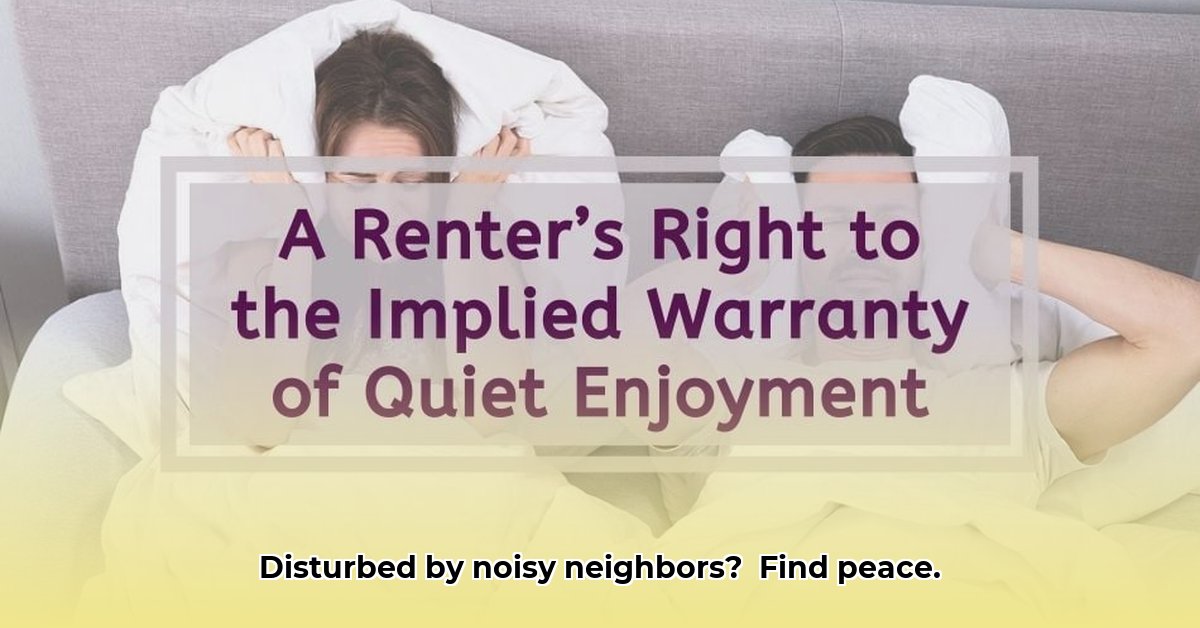
Understanding Your Right to Peace and Quiet
Enjoying your home peacefully is a fundamental right. Legally, this is often referred to as your "right to quiet enjoyment." This doesn't mean absolute silence, but it does mean freedom from unreasonable disturbances that significantly impact your ability to live comfortably in your property. It's a balance between your right to peace and your neighbor's right to use their property. Where that balance is disrupted, legal intervention may be necessary.
What Counts as a Disturbance?
Determining what constitutes an "unreasonable interference" with your quiet enjoyment can be subjective. A barking dog might severely bother one person while another barely notices it. Several key factors are considered:
- Frequency: How often does the disturbance occur? A single loud party differs significantly from nightly noise.
- Duration: How long does the disturbance last? A short burst of noise is less impactful than prolonged noise.
- Intensity: How loud or severe is the disturbance? A low hum is less disruptive than a jackhammer.
- Impact: How significantly does the disturbance affect your use and enjoyment of your property? This is arguably the most important factor.
For example, a neighbor's dog barking incessantly throughout the night, preventing sleep, is likely a significant disturbance. Conversely, a single annual block party is generally not considered a major issue. The context, frequency, intensity, and impact are all crucial in determining if a disturbance is legally actionable.
Common Issues Affecting Your Peace of Mind
Many everyday situations can infringe on your quiet enjoyment. These include:
- Excessive Noise: Loud parties, construction noise, constant barking dogs, or loud music late at night. Consistency and intensity are key.
- Unpleasant Odors: Strong, recurring smells from nearby businesses, compost heaps, or poorly maintained septic systems.
- Trash and Debris: Illegal dumping on your property.
- Access Issues: Blocked driveways, walkways, or other access points.
- Property Line Encroachments: Overhanging tree branches or fences encroaching on your land.
- Light Pollution: Excessive bright lights from a neighbor's property.
- Unreasonable Late-Night Activity: Persistent noise from late-night gatherings or work that disrupts sleep.
Your Action Plan: Steps to Reclaim Your Peace
If your quiet enjoyment is disturbed, follow these steps:
Keep a Detailed Record: Document every instance of the disturbance. Note the date, time, duration, type of disturbance, and its impact on you. Include photos or videos if possible. This detailed record is crucial for any future action.
Attempt a Friendly Conversation: Try talking to your neighbor or landlord first. A simple conversation can sometimes resolve misunderstandings.
Consider Mediation: If a direct conversation fails, mediation by a neutral third party can facilitate a mutually acceptable solution, preventing escalation to legal action.
Seek Legal Counsel: If all else fails, consult a lawyer or legal aid organization. They can advise you on your rights and next steps, such as filing a formal complaint or pursuing a lawsuit.
Local Laws: Your Legal Allies
Familiarize yourself with local zoning laws and ordinances. These often cover noise levels, construction hours, and other potential nuisance issues. Understanding these regulations can strengthen your position if you need to take further action.
Potential Problems and Solutions
Here are some common scenarios and potential solutions:
| Situation | Potential Solutions |
|---|---|
| Loud Construction Next Door | Talk to the contractor, review their permit, consider mediation or legal action if necessary. |
| Noisy Neighbors | Friendly conversation, written complaint, mediation, potentially legal action. |
| Poorly Maintained Property | Document the issue, notify the homeowner/landlord, report code violations to local authorities. |
| New Development Nearby | Attend community meetings, express concerns to developers or local government. |
Remember, your right to quiet enjoyment is important. Taking proactive steps, communicating effectively, and seeking professional advice when needed will help you protect this right and maintain a peaceful home environment. The goal is a resolution that respects everyone's rights while maintaining peaceful co-existence.
How to Prove Substantial Interference
Key Takeaways:
- Thorough documentation is crucial for proving substantial interference.
- Negotiation should be your first approach to resolving disputes.
- Understanding local laws and regulations is essential.
- Legal action should be considered if amicable solutions fail.
Defining Quiet Enjoyment and Nuisance
Quiet enjoyment is the right to use your property without unreasonable disturbances. A "nuisance" is an action that interferes with this right. It's a matter of degree; a single loud party is different from consistent nightly noise.
Proving Substantial Interference
To prove substantial interference, demonstrate that the disturbance significantly affects your use and enjoyment of your property. This requires evidence of the disturbance's frequency, intensity, duration, and impact on your life.
Documentation
Maintain meticulous records detailing each incident, its impact on you, and any attempts at resolution. Include photos, videos, recordings, and witness statements if available.
Negotiation and Mediation
Attempt to resolve the issue amicably through conversation or mediation before resorting to legal action.
Formal Complaints and Legal Action
If negotiation fails, consider filing formal complaints with your HOA or local authorities, or pursuing legal action. Your documented evidence will be crucial for a successful outcome.
Local Laws and Regulations
Research your local zoning laws, noise ordinances, and landlord-tenant rules to understand applicable regulations and strengthen your legal position. Proactive measures, clear communication, and knowledge of your rights are key to protecting your quiet enjoyment.